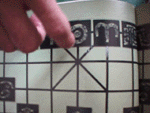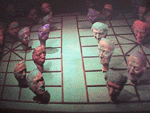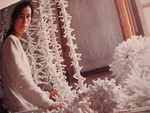| London has tracked down a fast internet connection. Yu Huang, along with a buddy who recently returned from New York, have formed a computer company called 5415 Company. The number is the phonetic equivalent of "I am a wild tiger." As their first major project, the partners are compiling a "Yahou" type of database for China, which they will mirror in New York. |

|
Detail of installation "God Playing Chess N1. Dragon beneath Earth" (1989) |
| Xu fingers the key area on a Chinese chess board - the box called the nine point palace. The box has nine points, which are numbered so that the three numbers along any of the six lines in the box adds up to nine. The center point of the box is known as "nine-five," another name for the emperor. | "All people are fascinated by numbers," Xu contends. |
| More importantly, Xu sees Chinese chess as a metaphor for the way China differs from the West. |
| The king and queen, for example, on a western chess board can range over the whole board, but in the Chinese version of the game, the emperor and queen are confined to the nine point palace box. |
| "Chinese men only have one wife," Xu assures London. | The shapes at the edge of the board are Xu's version of chess pieces. Inquiring about the identity of the pieces -- which one is the king or the queen - London discovers another difference between the chess games. The emperor in Chinese chess has two queens. In this instance the game is archaic and does not apply to modern China. |
| "Playing Chess with Voltaire N1. Rival Camps of Culture" (1992) |

|
| On a Chinese chess board, Xu has set up the ultimate showdown between China and the West. For team China, Xu has selected 16 artist friends, and arranged their busts to face their western antagonists - 16 busts of Voltaire! Voltaire is also a familiar figure among artists. His is the bust that they draw, over and over again, in traditional drawing class. | For Chinese intellectuals, Voltaire embodies the Enlightenment, the driving force of Western achievement. |
|
Assistant President Xu talks about two trends in Chinese art - ( |
| After the talk with Xu, London realized that she had not yet contacted a single traditional artist. An understanding of the tension between contemporary artists and their traditional art brethren, who overwhelmingly dominate the Chinese art scene, is essential to understanding the social matrix of contemporary art. | London resolved to meet with a traditional artist within a few days. |
 |
Shi Hui with her constructions. |
| Shi's work will be included in a group show, "South of the Yangtze River," March 1998 in Vancouver. |

